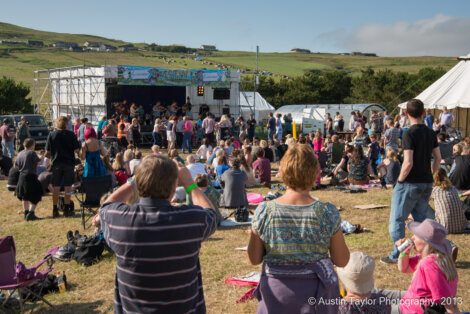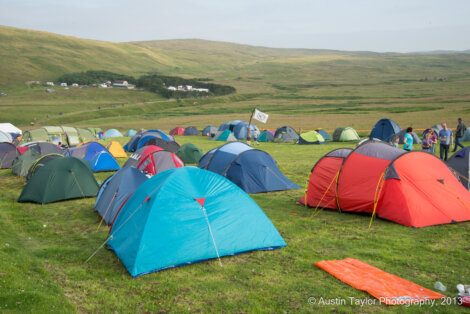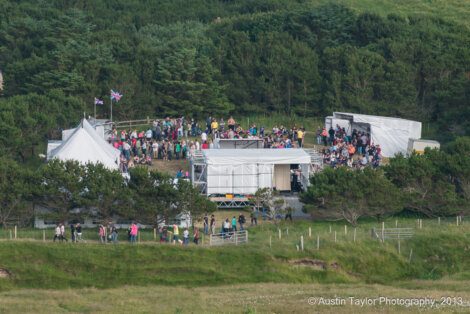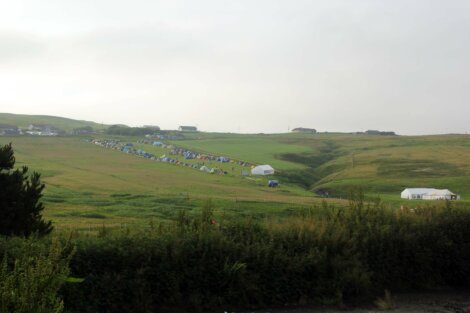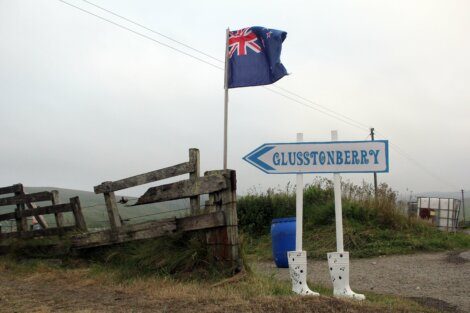Features / Ten years since Glusstonberry: ‘It really did bring folk together’
Some hailed it as the ‘best weekend ever’ – and the sun-kissed community-run festival will live long in the memory
EXACTLY ten years ago, hordes of people – more than a thousand in total – were flocking towards Gluss deep in Northmavine for a new music festival, probably not entirely sure what to expect.
The organisers – Northmavine Community Development Company (NCDC) – were not too sure how things were going to pan out either. How the stages would work, how transporting people into Gluss would work, how the campsite was going to work.
“But we kent the weather was going to be okay,” smiles NCDC’s Maree Hay. With the sun shining, and everything – pretty much – going to plan, Glusstonberry ended up an overwhelming success that lives long in the memory.
Some punters called the community festival, held on 20 and 21 July 2013, the “best weekend ever”, whilst some say it was the greatest event they have attended in Shetland.
“It really did bring folk together and folk had a fantastic weekend, and there was just no trouble, no bother, no hassle,” Hay recalls.
“We wanted to create a family atmosphere and I think that we did do that. When you saw toddlers wandering about with their tie dye tops and all that kind of thing that they bought at Glusstonberry…and afterwards we got such good feedback fae folk saying it had been the best weekend of their lives.”
Putting on a music festival anywhere in Shetland is no simple task – let alone out on the fields in Gluss, located in the Ollaberry area.
It was organised to fill a £13,000 funding gap NCDC was facing, but ended up raising £16,000. Since then the development company’s Polycrub business has exploded in popularity, providing steady income.
Local acts First Foot Soldiers and Fullsceilidh Spelemannslag were tasked with headlining, with stacked line-up of music across two stages.
Become a member of Shetland News
The name was a pun on the iconic Glastonbury Festival, and Shetland’s own had shades of Worthy Farm – from the trees surrounding the main site to the tie-dye ethos, a drumming workshop, a visit from the local jarl squad and impromptu conga lines in front of the main stage.
And then there was the camping. The campsite was located in a separate field some distance away, and many people took up the opportunity to sample that true festival experience by sleeping under the stars.
“The word slamping was invented,” NCDC’s Margaret Roberts says. “That’s camping on a slope, because our campsite was a peerie bit steeper than we thought originally.”
Festival-goers were warned beforehand that they could only take a “reasonable” amount of booze into the campsite. A subjective word for sure, but organisers said prior to the event this meant “12 tins of beer/cider etc, one bottle of spirits or two bottles of wine per person aged 18 or over”.
It was a spree, indeed, but the police were said to be delighted with how it all went – with no bother reported.
But before people could get to the campsite, they had to get to Gluss. Shuttle buses were organised from temporary carparks “far and wide”, while the single track Gluss/Bardister road was closed to all traffic with the exception of residents, blue badge holders, festival vehicles and the emergency services.
Oh, and the organisers had to find two places where a helicopter could land in case of emergency. Silage fields were picked for the temporary helipads, but thankfully they were never needed.
Then there were the many challenges around the amenities, in a such a rural location. Early on Roberts was delivered some sagely advice from a regular festival-going acquaintance.
“They said forget about bands,” she says. “Bands are no problem. Toilets is what you need to worry about. They were entirely right – toilets were the main challenge.”
Roberts lived nearby, and her large septic was used – “it was just a few inches from the top at the end of the weekend” – while slurry tankers were drafted in. Ness Engineering also emptied the other toilets which did not need to be connected.
A marquee was hired in from south, with a tractor needing to take it onto site, while a last-minute hitch meant the organisers had to provide their own security personnel.
With expensive sound equipment left out overnight, there needed to be some form of security keeping an eye on things – with Roberts one of two organisers who ended up sleeping on the stages.
“Not that I slept at all, because folk hadn’t really gone to bed – it was pretty noisy,” she reflects. Thankfully, there was no issue with folk interfering with the equipment.
A Glusstonberry ‘currency’ was used for payment for drinks – the booze also never ran out – while there was plenty of food on the menu too.
Hay admits that the organising committee initially knew little about putting on a festival, and there are sighs all around when speaking about the various regulations and hoops that needed to be jumped through before it could even go ahead.
She said there were four overarching aims: to get Northmavine and NCDC on the map, to involve volunteers and folk in the festival and to make money to plug the funding gap.
“Stupidly or otherwise we thought a music festival would be a good way of raising some money, and actually in the end it was – but we probably could have chosen an easier route.”
Another adventurous leap into the unknown was video broadcasting the festival live on the 60 North online channel. Those in charge were sat with their equipment in a Polycrub, sweltering in the heat, making sure the audio mix was right and switching between camera angles.
“I think one thing I remember – I think we were the only place in most of Shetland that actually had the sun,” Andy Steven, who led the broadcasting, reflects.
“We basically did it all from inside a greenhouse in the middle of nowhere.
“It was a challenge on many levels. We worked very closely with Ian Brown from Shetland Broadband, and there were all sorts of links powered by batteries put in to get us to somewhere that had a better link. I think that was back to Sella Ness.
“But the irony of it was because of the long lengths of links, I think when the tide changed, the signals dropped. We could stream well when the tide was in, but when the tide went out, we lost the signal for an hour or so.”
The temperature reading inside the polytunnel was “off the scale”, but the creative community pulled together despite the heat – with some of videos from the broadcast still available to view on YouTube.
“What I remember about that event…typical Shetland, if you have an idea and you bring the right people to the party you can basically do anything,” Steven says.
But what about the performers? Chloe Robertson featured twice on the bill, both as a solo singer-songwriter and as part of the group Comet Conspiracy.
Coincidentally her appearance came following coverage in the local media stating she was in fact set to play at Glastonbury – after a reporter misheard the word Glusstonberry.
“I definitely had more fun at Gluss than I would have if I actually had been playing Glastonbury,” Robertson says.
“I think the music scene at that time was so strong for younger acts, so it was a great laugh and really nice to sit back in sunny weather watching your pals performing.
“I remember in my set getting distracted halfway through and telling everyone to look at [photographer] John Coutts doing a flyover on his machine. It was that sort of event where everything felt so friendly and relaxed and there was a nice community feel – everyone was out to have a nice time and was happy to be there.”
First Foot Soldiers drummer Robert Balfour said his abiding memory of closing the Saturday night with his band’s raucous set was a “feeling of surrealism, as I had spent a lot of my youth in Gluss at my Nan’s, just across the field from the festival site”.
“I felt very proud to be part of the headlining act for such an occasion.”
Tom Morton hosted the smaller second stage, and he says he will never forget the “incredible” crowd that gathered to see Steven Robertson – famed for covers reworked with a Shetland comedy twang.
“Apart from that, I was on the organising committee and it must be said that Maree Hay worked incredibly hard, along with Margaret Roberts, to make it happen and to ensure it all went off with an astonishing lack of hitches,” he reflects.
“Special word too for Duncan Feather’s almost magical electrical and plumbing work.
“Without Glusstonberry, no NCDC, no Polycrub.”
Roberts meanwhile estimates that all in all around 1,600 people descended on Gluss on that famous weekend back in 2013.
“It’s a very peerie place,” she adds. “I saw everybody going afterwards and they were all waving, and saying ‘wooo!’ – they’d all had a really good time and that was the best thing about Glusstonberry, because folk had a really good time – and we raised money.
“There were six months of my life when I was either at work or obsessing about Glusstonberry. But that’s the only way you can organise something like that, is to get completely obsessive about it.”
The nagging question, though, is whether there will be a second Glusstonberry. Could you ever recreate the first one?
“We kind of jokingly spoke about ‘okay, well to mark the ten years we’ll try it again’,” Hay says. “But no, there’s no plans for number two.”
Roberts, meanwhile, feels that part of the charm first time around was that people turned up with an open mind – and no expectations.
“It was such a good festival,” she says, “that you would never manage to do it as well again.”
Become a member of Shetland News
Shetland News is asking its readers to consider paying for membership to get additional perks:
- Removal of third-party ads;
- Bookmark posts to read later;
- Exclusive curated weekly newsletter;
- Hide membership messages;
- Comments open for discussion.
If you appreciate what we do and feel strongly about impartial local journalism, then please become a member of Shetland News by either making a single payment, or setting up a monthly, quarterly or yearly subscription.






